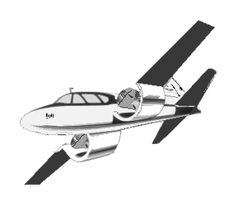Custer CCW-5
| CCW-5 | |
|---|---|
 | |
| Role | 5-seat light transport |
| National origin | United States |
| Manufacturer | Custer Channel Wing Corporation, Hagerstown, Maryland |
| First flight | 13 July 1953[1] |
| Number built | 2 |
| Unit cost |
$55,000 in 1955 [2] |
The Custer CCW-5 was a twin-engined, 5-seat aircraft of pusher configuration, which used a channel wing claimed to enable low speed flight and short take-offs. Two CCW-5s flew, eleven years apart, but the type never entered production.
The aircraft was the third and last of a series of Custer Channel Wing designs.
Design and development
In most situations an aircraft's lift comes chiefly from the low pressure generated on the upper surface by the locally enhanced higher air velocity.[3] This latter may be the result of the movement of the aircraft through the air or, when lift at low air speeds is important for short take-off performance, produced by engine power. The channel wing, the brainchild of Willard Ray Custer, is an example of the latter, where the air velocity over the upper surface velocity in a U-shaped channel formed out of the wing was increased with a pusher propeller at the trailing edge. This near semi-circular channel laterally constrained the airflow produced by the propeller, even when the aircraft was at rest, producing higher flow velocities than over a conventional pusher wing. The need for wing mounted pusher engines made a pusher twin a natural configuration, and for his third channel wing design Custer chose to modify the existing Baumann Brigadier, a 5-seat mid wing pusher twin which itself did not reach production.[4][5]
_MAAM_Reading_PA_27.04.04R_edited-2.jpg)
The CCW-5 retained the fuselage and empennage of the Brigadier, but replaced the whole centre section with a pair of channels, starting at roots in the lower part of the fuselage. Only beyond the channels did the conventional wings regain their mid-wing configuration. A 225 hp (168 kW) Continental O-470 flat six engine was mounted on slender vertical and horizontal struts at the centre of each the channels, on the mid-wing line. These drove constant speed pusher propellers. The main undercarriage was much shortened by mounting its legs on the outer part of the channel section; the Brigadier nosewheel was retained.[4][5]
The first of two CCW-5s flew on 13 July 1953, piloted by Walker Davidson, at Oxnard, California[4][5] and was reported to have completed its test flying by autumn 1956, when production was scheduled to begin.[4] This did not happen, though a second aircraft flew in June 1964.[5] The delay was partly the result of financial problems, though the CCW-5 performed well below the original estimates, with a maximum achieved speed of 220 mph (354 km/h) compared with an estimated 300 mph (480 km/h).[5] It was claimed that the aircraft could fly under control at 11 mph (18 km/h) and that it could take off with a 1,500 lb (680 kg) load at 70% power in 90 ft (28 m).[4]
The second CCW-5 was finished in 1964 with 260 hp (194 kW) Continental IO-470P engines;[2] it survives and is under restoration at the Mid-Atlantic Air Museum, Reading, Pennsylvania.
Specifications

Data from Jane's All the World's Aircraft[4]
General characteristics
- Crew: 1
- Capacity: 4 passengers
- Length: 28 ft 8.5 in (8.750 m)
- Wingspan: 41 ft 2 in (12.55 m)
- Height: 10 ft 10 in (3.30 m)
- Empty weight: 3,000 lb (1,361 kg) design weight
- Gross weight: 5,400 lb (2,449 kg) design weight
- Fuel capacity: 200 US gal (757 L; 166 Imp gal)[6]
- Maximum gross weight: 6,000 lb (2,722 kg)[6]
- Landing speed : 15 mph (24 km/h)[6]
- Landing and take-off distances: 100 ft (30 m)[6]
- Powerplant: 2 × Continental O-470-A flat 6-cylinder air-cooled, 225 hp (168 kW) each
Performance
- Maximum speed: 220 mph (354 km/h; 191 kn) [5]
- Cruise speed: 180 mph (290 km/h; 156 kn) [5]
- Range: 1,680 mi (1,460 nmi; 2,704 km) [5]
- Service ceiling: 20,000 ft (6,100 m) [5]
- Rate of climb: 3,000 ft/min (15 m/s) .[6]
Notes
References
| Wikimedia Commons has media related to Custer CCW-5. |
- Anderson, John D. Jnr. (2007). Fundamentals of Aerodynamics. McGraw Hill. ISBN 007 125408 0.
- Allum, Clifford (17 November 1958). "Channel Wing's Second Chance". American Aviation. 22 (13): 45.
- "Aerofiles: Custer". Retrieved 2010-04-03.
- Bridgman, Leonard (1956). Jane's All the World's Aircraft 1956-57. London: Jane's All the World's Aircraft Publishing Co. Ltd.